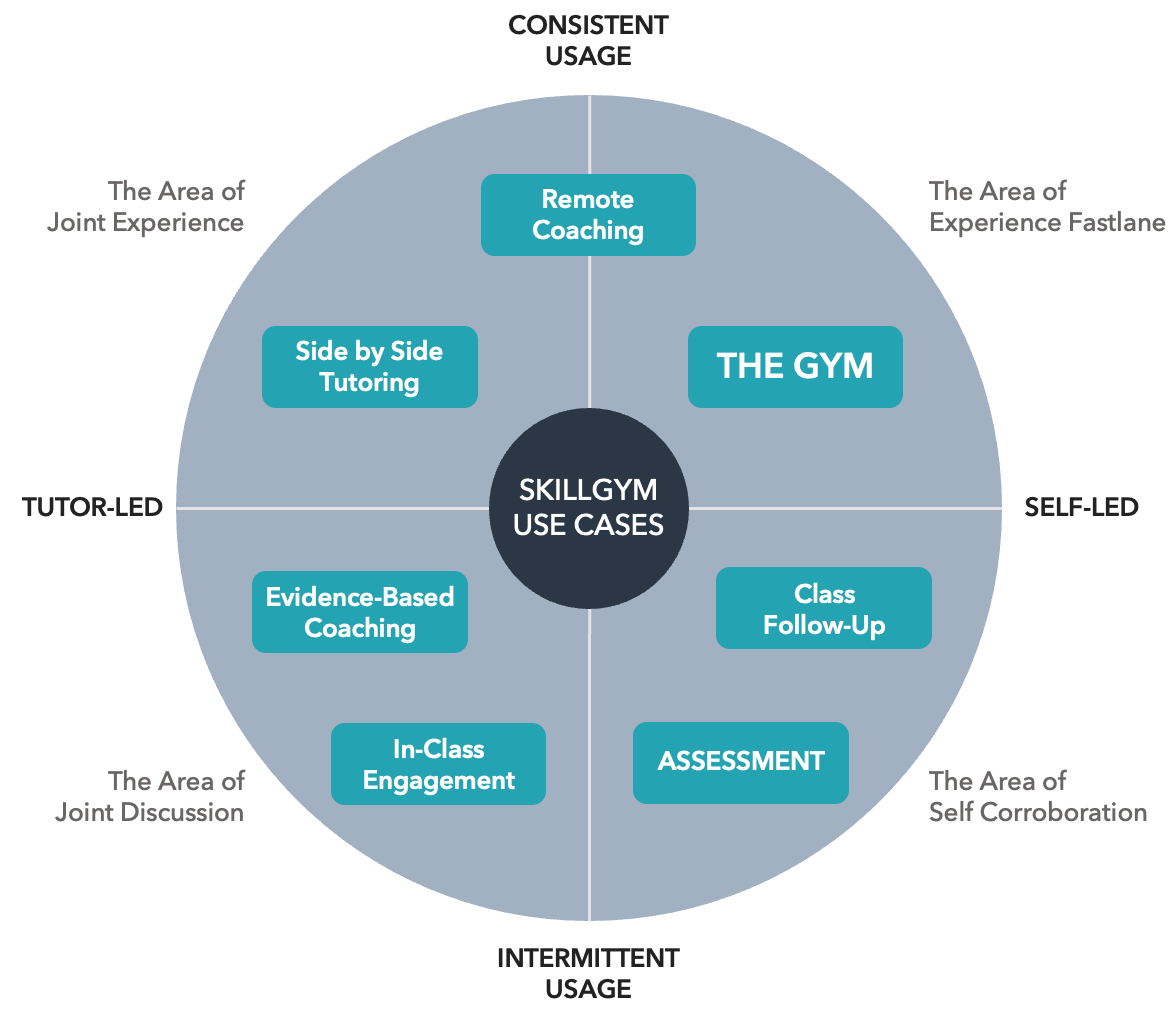
SkillGym was designed with the Gym in mind. The idea is that our behaviors can be consistently trained and improved through practice.
In another article (“From Critical to Empowering Conversations: let’s change the world using the C-FACTOR“) we discussed the importance of practice-based learning and we also addressed the idea of flipping the traditional leadership training strategies upsidedown by introducing a mind blowing way of upskilling-by-doing in leadership (“Flipping the Leadership Development Strategy with Actionable and Scalable Programs“).
Today I want to focus my attention on providing a more general overview of the six main ways of making the best of SkillGym.
Let’s start by visualizing the following conceptual map:

As you can see, I have split all the possible situations into four main areas that I call:
- The area of Experience Fastlane.
This is where practice comes first. It’s where trainees train on their own with consistency to permanently change their communication behaviors. - The area of Joint Experiences.
This is where organizations can think about optimizing their resources by leveraging the experience of their senior managers and executive coaches. - The area of Joint Discussions.
This area covers the cases were trainer and trainees, as well as coach and client, sit together side by side and use SkillGym as a way to start and empower a discussion around conversational behaviors. - The area of Self-Corroboration.
Finally, in this area trainees can dedicate their time to improving their understanding of leadership techniques as well as testing their own capabilities.
Let’s review the six use cases, one by one.
Use case 1 – The Gym
This is by far our most popular use case.
SkillGym was born to revolutionize the way people improve their behavior in business conversations. It is a gym that trains us to get better and better every day.
This use case belongs to the EXPERIENCE FASTLANE area.
In this area, the user makes the most of our brain’s learning mechanisms and quickly transforms volatile knowledge into solid experience-based behavior.
In this use case, the typical learning approach is that of self-led, consistent usage. This means that the trainee trains alone, sometimes it can be supported by a tutor or peers.
Pace of training is moderate: in fact, consistency in use is essential to consolidate new behaviors and intensity is low. We calculate that on average, the typical trainee trains for around 40 min / week. This means playing one conversation per week and it’s totally sustainable even for the busiest managers out there (especially with the help of the Butler).
Our field experience shows that the typical expected result of this use case (provided that trainees follow the formula in terms of pace and consistency as recommended by the relevant SkillGym program) is a change of behaviors.
Evidence shows that gym boot camps permanently impact unconscious behaviors by eliciting our limbic system through emotion-based experience.
The typical user experience of this use case is well represented by this comment, which was provided by one our client’s Chief Learning Officer:
“Practicing takes the entire learning experience to the next level, it’s absolutely worth doing it.”
Henry, Chief Learning Officer – Retail
Use Case 2 – Remote Coaching
We have discussed in several case studies where SkillGym can play a great role in supporting executive and leadership coaching.
This article, for example, covers four great case studies on this topic (“Four case studies about how SkillGym supports leadership coaching“).
Many of our case studies get around the so-called remote coaching.
Coaching can be scaled by supporting trainees remotely when they need it.
SkillGym dashboard and Augmented Replay let you schedule laser-focused and very effective interventions.
This use case belongs to the EXPERIENCE FASTLANE area.
In this area, the user enjoys the benefits of both being followed by a coach and of being able to organize the training schedule themselves.
The typical approach we recommend is that the trainee trains alone, but discusses the outcomes of the conversation remotely with a coach. Consistency in use is essential to consolidate new behaviors. Intensity is low (40 min / week).
This means, once again, playing one conversation per week, which is totally sustainable even for the busiest managers out there (especially with the help of the Butler).
The primary result expected from this use case is raising self-awareness. Evidence shows that remote coaching on SkillGym contributes to the increase of self-awareness thanks to the combination of SkillGym feedback and coach support.
The typical user experience of this use case is well represented by this comment, which was provided by one our client’s trainees:
“I really felt I could count on my coach and still, I was free to organize my time.”
Betty, Area Manager – Bank
Use Case 3 – Side-by-Side Tutoring
Side-by-side tutoring is very popular nowadays. However, it has proven to be very expensive and not highly scalable.
Human resources are scarce and assigning one tutor full-time to each single trainee is not sustainable in the long run.
Thanks to SkillGym, experienced managers can support the growth of a younger generation by playing life-like scenarios jointly in real-time and then discussing it together.
This can definitely be defined as the evolution of field coaching.
This use case belongs to the area of JOINT EXPERIENCES.
In this area, the user has the option of a discussion with an experienced in-person tutor, typically a more senior manager.
The trainee meets the tutor in person and dedicates part of the session to side-by-side digital role play. We typically expect one or more conversations to be played during the tutoring session (15-30 min / session).
Evidence shows that side-by-side tutoring on SkillGym contributes to an increase in confidence in conversations thanks to the combination of SkillGym feedback and the support of the tutor.
The typical user experience of this use case is well represented by this comment, which was provided by one of our client’s trainees:
“It’s a great way of sharing my 30-years experience: facing real situations without leaving my office.”
Jim, Senior Manager – Manufacturing
Use Case 4 – Evidence-Based Coaching
Coaching is evolving as a result of a series of market inputs that are rapidly changing how things get done in this industry.
I have discussed this topic extensively in this article (“Boosting leadership coaching with Digital Role Play“).
Evidence-Based Coaching belongs to the area of JOINT DISCUSSIONS.
In this area, the user has the opportunity to discuss the way conversations should be managed with an experienced in-person coach.
The approach is what we call Tutor-Led, Intermittent usage.
The trainee meets the coach in person and dedicates part of the session to side-by-side digital role play. One or more conversations are normally played during the coaching session (15-30 min / session).
The expected results here are that evidence will be clear . Executive coaches can count on a very sharp way of making behavior patterns emerge from simulated conversations.
Check out this very interesting article (“Four case studies about how SkillGym supports leadership coaching“) where I cover four amazing case studies showing the flexibility of SkillGym in executive coaching.
The typical user experience of this use case is well represented by this comment, which was provided by one of our clients:
“I can actually witness the way my client interacts with other people in certain situations.”
Katy, Executive Coach
Use Case 5 – In-class Engagement
Of course, classes are the number one choice of many trainers when it comes to leadership programs.
If you have read some of my articles already, you know my position on the importance of increasing practice-based learning and reducing class-based learning.
My colleague Matteo also wrote an interesting article on this specific topic; you can find it here (“Flipping the Leadership Development Strategy with Actionable and Scalable Programs“) and I highly recommend reading it.
Classes are still an essential component to any balanced training strategy on leadership and SkillGym fits very well with this approach; especially because it contributes to a more interactive approach among participants.
In fact, SkillGym allows trainers to make the best of their class-based training.
They can split the audience in groups, assign a digital role play and let the discussion flow. It’s the best way to define the real learning objectives.
This use case belongs to the area of JOINT DISCUSSIONS.
In this area, users enjoy the possibility of group-based discussion that can lead to a clearer definition of their needs and learning gaps.
Trainees sit in a group around the simulation, they play jointly and discuss the strategy and the outcomes.
One or more conversations played during the class session + discussion (45-120 min / session).
The expected result is group discussion.
Trainees get caught up either by competitiveness or collaboration. In both cases, the discussion flourishes and individual experiences are shared.
The typical user experience of this use case is well represented by this comment, which was provided by one of our clients:
“That was so exciting! These characters are so real…”
Tom, First-Time Manager – Insurance
Use Case 6 – Class Follow-Up
Class follow-up is another popular approach for leadership training.
Thanks to SkillGym, trainers can turn the old-style after-class exercises into something their trainees will love.
They can assign a deep-dive into role playing and make sure that concepts are truly understood.
This use case belongs to the area of SELF-CORROBORATION.
In this area, the user can integrate the knowledge acquired in class with practical and life-like examples of how that knowledge should be applied.
The typical approach is that of self-led, intermittent usage. The trainee trains alone, typically after a class on soft skills is over.
The pace typically recommended is three to four conversations / week for one or two weeks (120 min / week).
The most typical expected result here is a better understanding of the concept discussed in class.
Having the possibility to try out what was learned in class is the best way to increase the level of understanding of concepts.
The typical user experience of this use case is well represented by this comment, which was provided by one of our clients:
“This was the most innovative course I have enrolled in, totally engaging.”
Brad, First-Time Manager – Retail
Use Case 7 – Assessment
Assessment is the last approach we consider in this article, but certainly one of the most populars in terms of usage.
Thanks to SkillGym, trainers and assessors can turn the old-style multiple-choice questionnaire – but also many in-basket assessments into something much more engaging and realistic.
They can assign a deep-dive into role playing and make sure user’s true reactions and attitude are carefully measured.
SkillGym on average measures up to 80 different KPIs – the actual number varies according to the simulation library you decide to use. You can remap the aggregation of skills (possibly excluding some) to fit your own competency and capability model. In this way the system adapts the classification criteria according to the specific business needs.
Here are the four main benefits of using SkillGym as assessment tool:
- MEASURE by DOING. Objectively observing a behavior that is acted in a context in which the candidate is immersed offers a much broader range of elements that can be considered in the assessment.
- SCALABILITY. SkillGym allows you to reach thousands of candidates at the same time and to immediately make available the data already structured and organized to be integrated in the selection process.
- METRICS DRIVEN DECISIONS. SkillGym provides detailed metrics that objectively measure the prevailing attitude and the related observable behaviors
- EMPLOYER BRANDING. Millenials are digital. And they seek working contexts that “speak their language”. SkillGym is an excellent and innovative business card with which to present your company to the new generations.
What’s next
If you are looking around to find the Digital Role Play solution that suits your needs, please browse through our website, which contains a volume of inspiring content including pre-recorded webinars and articles.
If you’d like to book a free call with us, we would welcome the opportunity to discuss SkillGym with you further.
Enjoy the rest of your day.

